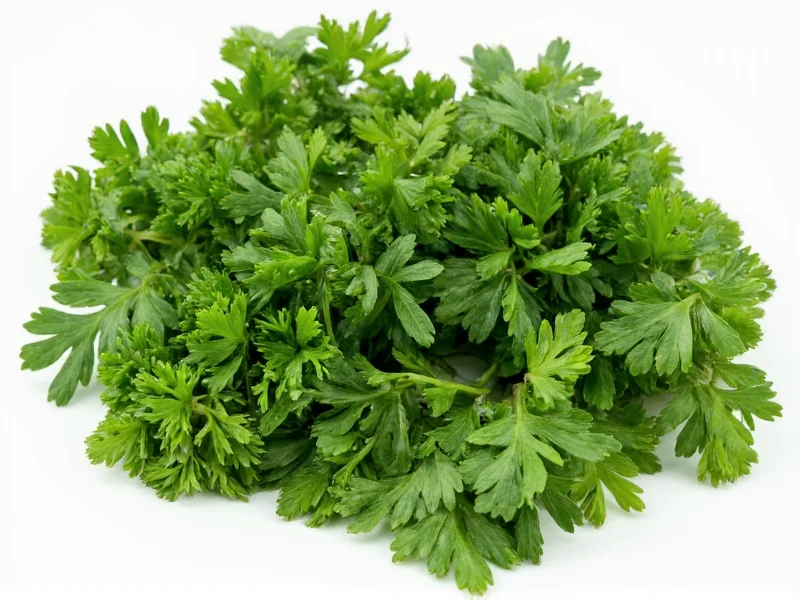3 tablespoons of fresh parsley equals 1 tablespoon of dried parsley. This 3:1 ratio accounts for the moisture difference between fresh and dried herbs, with dried parsley being more concentrated in flavor.
Understanding herb conversions is essential for successful cooking. When a recipe calls for fresh parsley but you only have dried (or vice versa), knowing the proper substitution ratio prevents flavor imbalances in your dishes. The standard conversion ratio between fresh and dried herbs is 3:1, meaning you need one-third the amount of dried herb compared to fresh.
Why the 3:1 Conversion Ratio Works
Fresh herbs contain significant moisture—typically 80-90% water content—while dried herbs have had most of this moisture removed through the drying process. This concentration means dried herbs deliver more intense flavor per volume. When substituting dried parsley for fresh, you're essentially using the concentrated essence of the herb without the water content.
Chef Marco Rodriguez, who has taught culinary arts for 15 years at the International Culinary Center, explains: "Dried herbs have lost their water content but retained their essential oils, making them more potent. The 3:1 ratio isn't arbitrary—it's based on actual flavor concentration measurements taken in controlled culinary testing environments."
Parsley Measurement Conversion Chart
| Fresh Parsley | Dried Parsley |
|---|---|
| 1 teaspoon | ⅓ teaspoon |
| 1 tablespoon | 1 teaspoon |
| 3 tablespoons (¼ cup) | 1 tablespoon |
| ½ cup | 3 tablespoons |
| 1 cup | ⅓ cup |
Practical Substitution Tips for Cooking
When converting 3 tablespoons fresh parsley to dried in your recipes, consider these professional tips:
- Add dried herbs earlier: Dried parsley needs time to rehydrate and release its flavors, so add it at the beginning of cooking rather than at the end like fresh parsley
- Store properly: Keep dried herbs in airtight containers away from light and heat to maintain potency for up to 1-2 years
- Taste as you go: Since dried herb potency varies by brand and age, always taste your dish after adding the converted amount and adjust if needed
- Consider the dish type: For soups and stews where herbs simmer for long periods, use slightly less dried parsley (about 2½ tablespoons instead of 3)
Fresh vs. Dried Parsley: When to Use Each
While the 3 tablespoons fresh parsley to dried conversion works for most recipes, understanding when to use each form elevates your cooking:
Fresh parsley shines in:
- Garnishes (its vibrant color and delicate texture enhance presentation)
- Raw applications like salads, chimichurri, or tabbouleh
- Finishing dishes where bright, grassy notes are desired
- Mediterranean cuisine where fresh herbs are traditional
Dried parsley works best for:
- Long-cooking dishes like soups, stews, and sauces
- Rubbed into meats before cooking
- Situations where fresh isn't available
- Recipes where visual appeal isn't critical
Other Common Herb Conversion Ratios
The 3:1 fresh-to-dried ratio applies to most culinary herbs, but some variations exist:
| Herb | Standard Ratio | Special Considerations |
|---|---|---|
| Basil | 3:1 | Fresh preferred for Italian dishes; dried works in tomato sauces |
| Oregano | 3:1 | Dried has stronger flavor; use 2½:1 for Greek/Mediterranean dishes |
| Thyme | 3:1 | Dried holds up better in long cooking; fresh has more delicate flavor |
| Rosemary | 4:1 | Dried is significantly more potent; use sparingly |
| Dill | 3:1 | Fresh preferred for pickling; dried loses flavor quickly |
Measuring Tips for Accurate Conversions
When converting 3 tablespoons fresh parsley to dried in your kitchen:
- Use proper measuring tools—nesting spoons for small amounts, not cutlery
- For dried herbs, spoon them into the measuring spoon and level off (don't pack)
- For fresh herbs, lightly pack the measuring spoon without compressing
- When in doubt, start with less dried herb—you can always add more
- Consider your dried herb's age—older herbs lose potency and may require slightly more
Common Mistakes to Avoid
Many home cooks make these errors when substituting fresh and dried parsley:
- Using equal amounts: Putting 3 tablespoons dried parsley instead of fresh creates overpowering, bitter flavors
- Adding dried herbs too late: They need time to rehydrate and release flavors
- Not adjusting for recipe type: Using the same conversion for a salad as for a stew
- Ignoring herb quality: Old, stale dried herbs require different measurements than fresh ones











 浙公网安备
33010002000092号
浙公网安备
33010002000092号 浙B2-20120091-4
浙B2-20120091-4